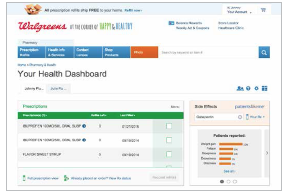Walgreens and PatientsLikeMe Bring Drug Information to Consumers
Trending now: Technology-enabled consumer health engagement is on the rise.
 Walgreens and PatientsLikeMe
Walgreens and PatientsLikeMe
Walgreens is adding data from PatientsLikeMe to its online health dashboard, giving patients a view of possible medication side effects sourced directly from other patients. Anyone researching a medication or filling a prescription on Walgreens.com can access a simple snapshot that shows how their prescribed medication has impacted other patients on the therapy, including medication side effects, as reported by PatientsLikeMe members.
Walgreens can access PatientsLikeMe content to share information that may be of interest to Walgreens patients based on individual medication needs.
The partnership is a first for both companies: PatientsLikeMe has never before allowed its data to be displayed on another company’s website, and Walgreens has never before featured externally contributed data on its health dashboard.
To access patient-reported data on medication side effects, Walgreens patients can go to the pharmacy’s website. Walgreens patients interested in connecting with other patients managing similar conditions and sharing their medication experiences through PatientsLikeMe can visit patientslikeme.com/join/walgreens.
Driving Behavior Change with Rally Platform
Rally Health, a developer of data-driven solutions has created a HIPAA-compliant platform that leverages the power of personal health data, social networking, and gamification to drive behavior change. Available to consumers through health plans and employers, Rally is a multi-payer, multi-channel platform. The company is a primary provider of digital wellness solutions for UnitedHealth Group and is expanding its customer base through relationships with institutions such as Health Alliance Medical Plans, with more than 5 million people already onboarded to the platform.
According to a Forbes report, besides rewarding members with Amazon gift cards, Rally Health compensates eligible employees with hundreds of dollars in premium discounts, or tax-free money in a health savings account. Those kinds of incentives could prove instrumental in sustaining motivation and engagement long term, something of a challenge for wellness programs.
Klick Study: Digitally Active Patients Feel Better
Digitally active chronic patients are satisfied with their health despite the fact they appear to be sicker than those not using technology to help manage their conditions, according to new research findings from Klick Health, Google, and the Digital Health Coalition. The #LivingBetter study found that of the 18% of chronic patients who frequently use digital technologies for health reasons, 70% define the state of their health as good, very good, or excellent — even though 43% admitted to visiting a hospital emergency room in the last six months and 32% were hospitalized for at least one night.
In comparison, digitally inactive patients, which represent 35% of those surveyed, said they were in similar health but only 20% of them went to the ER and only 11% were hospitalized over the same time period.
“Digital is playing a huge role in how patients are engaging with their care," says Peter Flaschner, senior VP, client experience, at Klick.
Other key findings include:
18% of chronic patients use digital on a daily/weekly basis, 47% use the Internet to search for health information a few times a year or more; and 35% don’t use digital for health at all.
Patients are researching their health across the patient journey, notably pre- and post-doctor visits, after therapies have been prescribed and when patients have issues and/or free time.
Like most Americans researching health, chronic patients go to popular online health portals, like WebMD, however they over-index relative to the general population using online forums (38% vs. 20%).
Of the 19% of patients who use mobile for health-related activity, a significant number expressed strong interest in more data-driven, patient-physician interaction.
80% of them are interested in getting health apps from their doctors;
75% would use apps to connect with their doctors.
FDA Launches Drug Shortages Mobile App
The FDA has created the agency’s first mobile application specifically designed to speed public access to valuable information about drug shortages. The app identifies current drug shortages, resolved shortages, and discontinuations of drug products. Drugs in short supply can delay or deny needed care for patients. Drug shortages may also lead healthcare professionals to rely on alternative drug products, which may be less effective or associated with higher risks than the drug in shortage.
“The FDA understands that healthcare professionals and pharmacists need real-time information about drug shortages to make treatment decisions," says Valerie Jensen, associate director of the Drug Shortage Staff in the FDA’s Center for Drug Evaluation and Research. “The new mobile app is an innovative tool that will offer easier and faster access to important drug shortage information."
App users can search or browse by a drug’s generic name or active ingredient, and browse by therapeutic category. The app can also be used to report a suspected drug shortage or supply issue to the FDA.
The agency developed the drug shortages app to improve access to information about drug shortages, as part of the FDA’s efforts outlined in the Strategic Plan for Preventing and Mitigating Drug Shortages. The app is available for free download via iTunes (for Apple devices) and the Google Play store (for Android devices). (PV)
The Network is a regular department in PharmaVOICE.


















